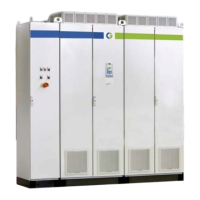CG Drives & Automation 01-7318-01r1 Control connections 29
5.5 Connecting the control
signals
5.5.1 Cables
The standard control signal connections are suitable for
stranded flexible wire up to 1.5 mm
2
and for solid wire up to
2.5 mm
2
.
Fig. 23 Connecting the control signals FDUL/VFXR46 - 109
to 250 and FDUG/VFXG46 - 109 to 250.
Fig. 24 Connecting control signal FDUL/VFXR46-375 to
500 and FDUG/VFXG46-350 to 500.
5.5.2 Types of control signals
Always make a distinction between the different types of
signals. Because the different types of signals can adversely
affect each other, use a separate cable for each type. This is
often more practical because, for example, the cable from a
pressure sensor may be connected directly to the motor
inverter.
We can distinguish between the following types of control
signals:
Analogue inputs
Voltage or current signals, (0-10 V, 0/4-20 mA) normally
used as control signals for speed, torque and PID feedback
signals.
Analogue outputs
Voltage or current signals, (0-10 V, 0/4-20 mA) which
change slowly or only occasionally in value. In general, these
are control or measurement signals.
Digital
Voltage or current signals (0-10 V, 0-24 V, 0/4-20 mA)
which can have only two values (high or low) and only
occasionally change in value.
Data
Usually voltage signals (0-5 V, 0-10 V) which change rapidly
and at a high frequency, generally data signals such as
RS232, RS485, Profibus, etc.
Relay
Relay contacts (0-250 VAC) can switch highly inductive
loads (auxiliary relay, lamp, valve, brake, etc.).
Control signals
connection
Screening
connection
Main switch Q1
L2L2
L1L1
RITTALRITTALRITTALRITTAL
RITTALRITTAL
RITTALRITTALRITTALRITTALRITTALRITTALRITTALRITTAL
RITTALRITTAL
MotorMotor
MotorMotor
Control signals
connection
Screening
connection
Main switch Q1
NOTE:
The screening of control signal cables is necessary to
comply with the immunity levels given in the EMC
Directive (it reduces the noise level).
NOTE:
Control cables must be separated from motor and mains
cables.
Signal
type
Maximum wire size
Tightening
torque
Cable type
Analogue Solid wire:
0.14-2.5 mm
2
(AWG 26 - 14)
Flexible wire:
0.14-1.5 mm
2
(AWG 26 - 16)
Wire with ferrule:
0.25-1.5 mm
2
(AWG 24 - 16)
0.5 Nm
(4.4 LB-in)
Screened
Digital Screened
Data Screened
Relay Not screened

